Recurring, repeatable or retainable revenues – what they really mean for investors.
Life as we know it in
the digitally connected, consumer driven world has undoubtedly come with many
benefits in terms of quality, experiences and efficiency. This has also come
with a set of fixed costs to the many consumers who subscribe to services like
mobile phone apps, streaming through Netflix, networking on LinkedIn or
shopping via Amazon. Companies providing these services naturally see the
opportunity to proliferate their technologies and create regular earnings
streams in the process. Now what does this mean for investors? How should the
prospect of recurring revenue be factored into a company’s valuation, and are
there subtle nuances with a company’s claim of perpetual revenue that warrant
caution?
It is commonplace these days, possibly bordering on the realm of jumping on the bandwagon, for companies to paint a picture of their revenues being recurring in nature. Generally speaking, the notion appears to instil a sense of business quality to investors. Hence, it comes as little surprise that management teams are increasingly reporting on revenues which are repeatable, recurring, or any other label that can be associated with this notion of somewhat bankable future earnings.
The theory behind this trend is that recurring revenue is more valuable than revenue which needs to be won from a customer each time they are engaged. Business owners would suggest that a captive customer base provides the basis for a more valuable business which can generate greater revenue than one which needs to continually secure new customers. At a baseline, generating revenue from existing customers will be achieved at a lower cost per dollar versus revenue from new customers, which should in turn improve profit margins and ultimately value.
The following charts provide a sample scenario of the two alternative revenue streams, being non-recurring revenue and recurring revenue. In the simplistic first charted scenario of non-recurring revenue, a customer pays $100 for an outright purchase, yielding a $10 profit per unit sold for the company. There are no other transactions that occur in subsequent months. At the end of the 12-month period, nothing has changed from the abovementioned transaction.
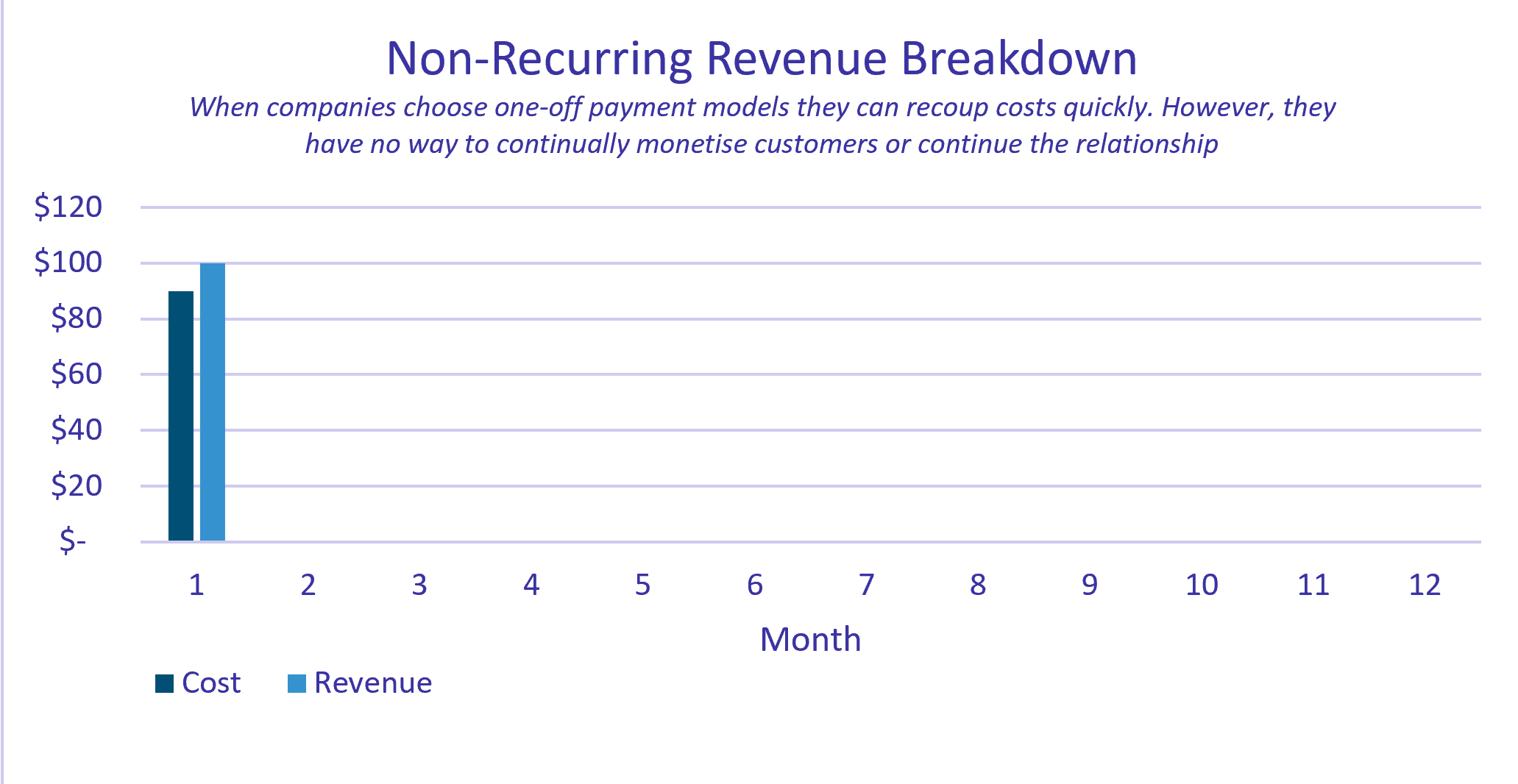
Source: NAOS, Price Intelligently
In the second chart, the recurring revenue scenario, the customer subscribes to a $10 per month offer for ongoing access. Every month they pay a $10 payment which at the end of the twelve-month period generates company revenue of $120. Despite this incremental payment profile, the majority cost of the unit is incurred prior to any revenues being generated. Therefore, the company is not generating a profit until at such time as the upfront (and minimal subsequent) costs are recovered through the cumulative incremental revenue. At the end of the twelve-month period, we can see more revenue and profit has been generated vs the non-recurring example. In addition, there is an opportunity to continue generating revenue in year two and beyond.
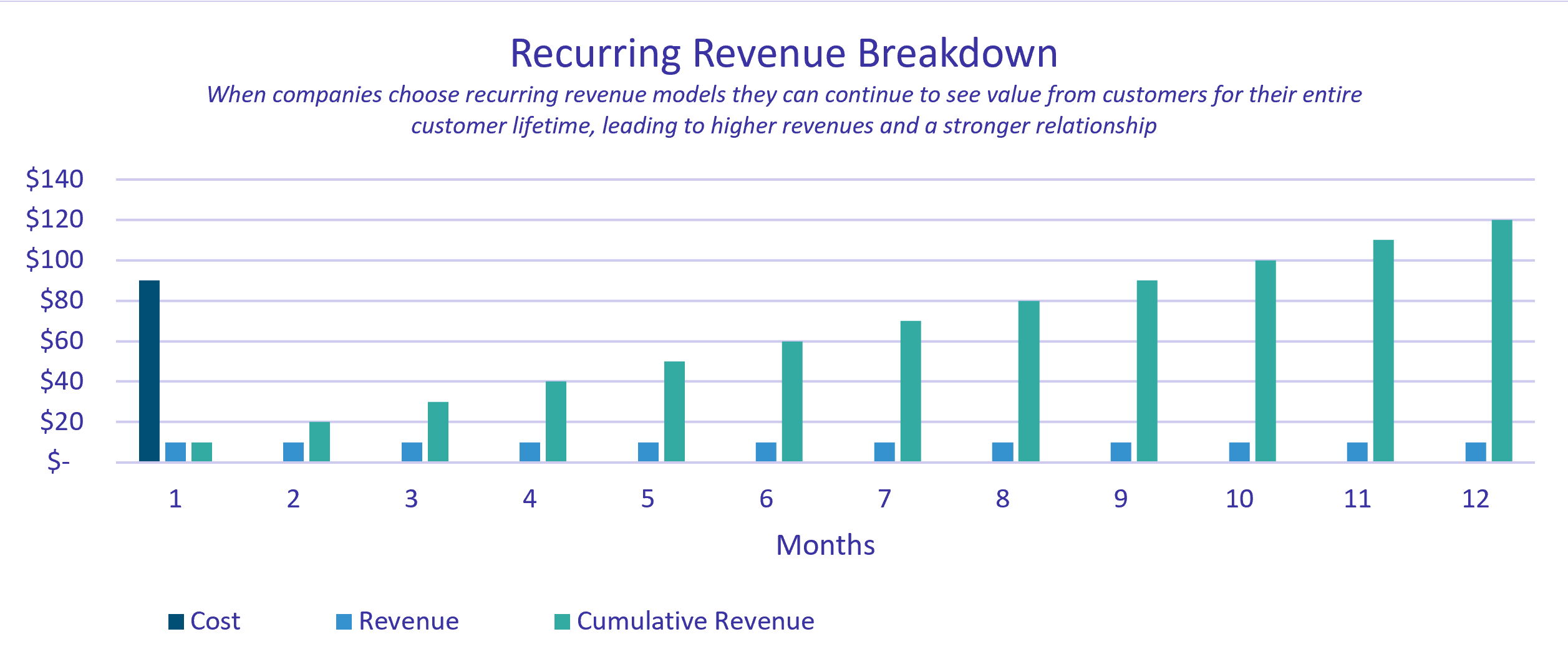
Source: NAOS, Price Intelligently

Based on the above, there is no denying that one could associate the quality of an underlying company’s operations with their ability to generate a consistent and growing revenue stream over time. But there are additional factors that make recurring revenue an attractive proposition for investors:
- Lower entry-level pricing – setting a nominal monthly price rather than an upfront investment reduces friction to purchase and can drive demand further;
- More touch points / Land & expand – re-engaging with the same customer provides the opportunity to deepen the relationship and cross-sell other products and services;
- Longer revenue streams / Stickier customers – happy customers improve the chances of retaining their business for longer;
- Network / Compounding effects – broadening the products and services sold to a customer can build a barrier of exclusivity when they integrate well with the customer’s business, thereby reducing the risk of losing their patronage to a competitor. A prime example of a network effect is in the iPhone. The power of Apple’s iOS platform and linkages to services like streaming or payment systems highlights their success in creating captive revenues.
Sector In Focus
The one area where recurring revenue has certainly been prevalent and is having ripple effects throughout the wider investment community is the software sector. Cast our minds back to the early 2000s when consumers would happily make a one-off purchase of Microsoft Office for a few hundred dollars or more. It’s a different model today, whereby the current generation Microsoft Office 365 is sold via an annual license fee in place of a one-off purchase cost. It’s a similar situation with Adobe, which has opted for a licence fee for its Creative Cloud suite in place of an individual software purchase.
One could argue this transition has created a win-win for software companies and consumers alike, as:
- Consumers pay a lower price in more frequent intervals and gain continual access to the latest product; and
- Software companies generate a far more predictable revenue stream that is larger over the long term knowing that consumers need to continue to pay the subscription to access this critical software and eliminating the ability for consumers to share licencing.
Defining Recurring Revenue
When we put our investment hat on, the widespread use of recurring revenue measures that companies may report to investors can often raise an issue of interpretation, as a variety of terms are used interchangeably to portray a revenue stream. Although some references may be similar, they don’t necessarily mean the same thing, so it is important for investors to appreciate the distinctions when reading company reports.
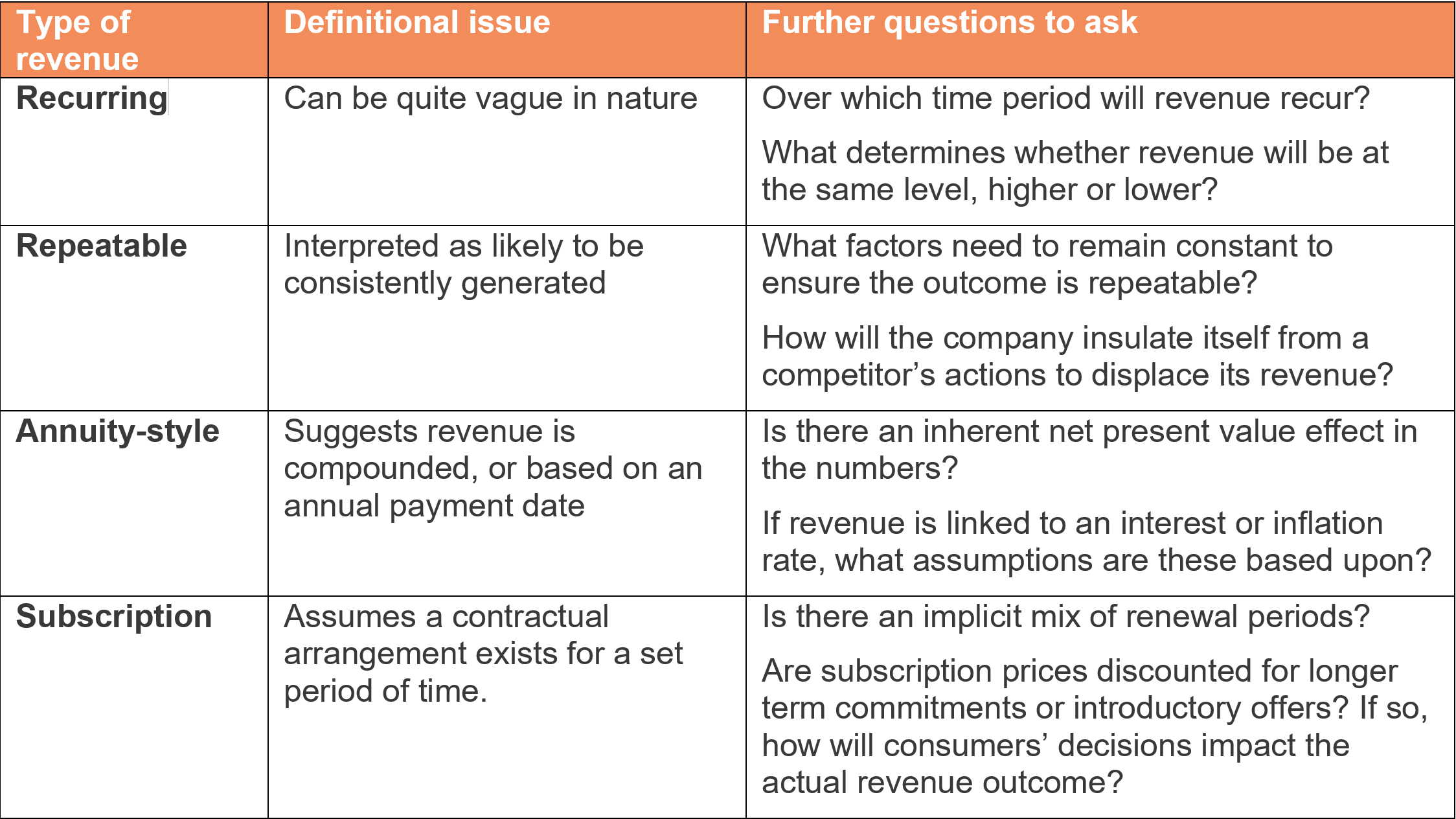
Diving Deep into Recurring Revenue
As investors, we seek to quantify revenue, expenses, and other variables to determine the present and future value of a company. In gathering our research, one term that we often see used in company reporting, especially within the software sector is ‘Annual Recurring Revenue’ (ARR). On the surface, it should represent a relatively easy calculation (being defined as revenue recurring for set periods of time that is annualised). However, this may not be the case.
As can be seen in the table below which provides an example of monthly revenue that is forecast to grow by 5%, the period chosen to be annualised (e.g., one month, four quarters or two halves) can generate a substantial difference in the ARR.

In addition to the above, it is important to consider the fundamental definition of what is deemed to be ‘recurring revenue’. Some companies may define recurring revenue to only include revenue that is effectively contracted to occur in the next 12-month period. Others may report based on an assumption of continued subscriptions even though they aren’t contractually bound to continue. This is where a difference between expected vs actual revenue can arise, resulting in materially different outcomes.

Devil in the detail
In assessing the validity of reported recurring revenue, investors need to be mindful of revenue items that may be bundled into total revenue but in reality may not be repeatable. This includes items like installation costs, support services, and training fees which may be charged initially and not be required on an ongoing basis. Furthermore, some of these ongoing revenues will likely reduce and/or cease at some stage in time once a customer is established. This being the case, the true definition of what is reasonably expected to occur can prove difficult to interpret. A discerning eye is required to assess what should realistically be counted as recurring.
Company In Focus – Pro Medicus Ltd (ASX: PME)
PME is a developer and supplier of healthcare imaging software and services to hospitals, diagnostic imaging groups and other related health entities in Australia, North America, and Europe. PME is a market leader in what they do. When screening the universe of ASX software companies for their breakdown of revenue (% recurring revenue vs % non-recurring), PME is a leader. Based on their most recent results, over 99% of their revenue was defined by the company to be recurring revenue. This is highlighted in the below chart.
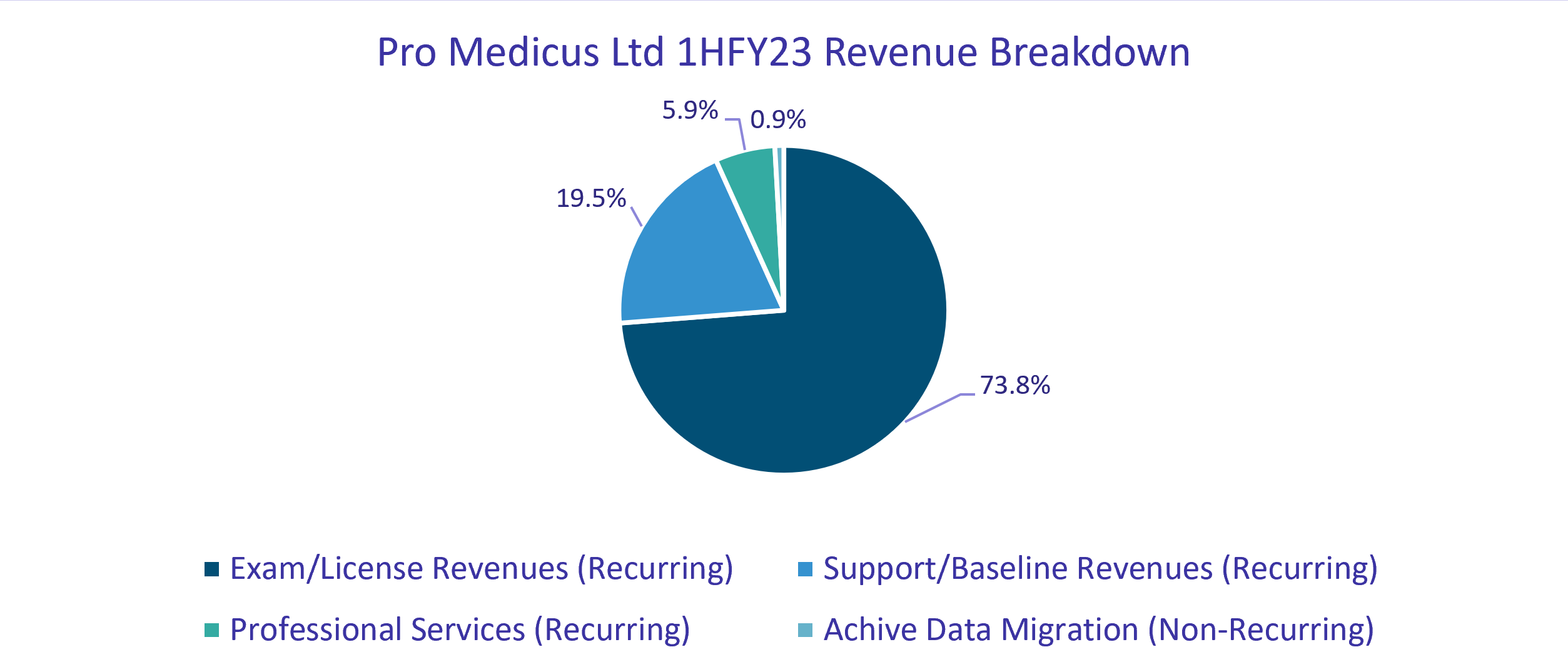
Source: PME 1HFY23 Investor Presentation
PME also outlined further detail on these particular revenue types highlighted by:
- Exam/License Revenues = A ‘per use’ rate charge under a long-term contract. Whilst transactional in nature, PME typically require minimum volumes of exam/licenses to be paid for within their contracts (i.e. customers pay for a certain number regardless of use).
- Support/Baseline Revenues & Professional Services = Fees paid by contracted customers recognised over the life of the contract for services such as installation, upgrades, training & support. Often these types of revenues are deemed to be largely related to upfront software installation (therefore non-recurring) however, instead of this, PME allocates their professional services revenues into an annual fee over the life of a contract (on the assumption that these services are consumed across the contract period), therefore it becomes a ‘smooth’ revenue profile and essentially recurring from a revenue standpoint for as long as the contract is in place.
- Archive Data Migration = A professional service of customer data migration onto the PME platform. Once this has occurred it does not need to occur again
Are as recurring as they appear to be? The short answer is yes. PME’s software and support services are highly interrelated, many of the services provided can only be provided by PME and the contracts signed with customers are typically long-term in nature (i.e. 5yrs+). Furthermore, the method for which they recognise revenue is clearly stated to be based on elapsed term of a contract vs the total contract term (i.e. 1/5 per year on a 5yr contract). When cross-referencing the above with the notes within the PME financial statements we can see that from a timing perspective of recognising revenue, there is nothing recognised at a certain ‘point in time’, meaning all revenues are recognised ‘over time’. Whilst this last point does not always mean they are recurring in nature, it can be a useful sense check.
Delving slightly deeper (and depending on your perspective) there are perhaps two elements of PME’s recurring revenue that one may wish to ponder:
· Will Exam/License Revenues over and above minimum commitment volumes recur at the same level every year?
· If a contract is in its final year of duration, could it still be deemed recurring if a renewal agreement is not yet signed?
Regardless, in our opinion, PME is a useful ASX case study on a very high-quality recurring revenue business. It has been a ‘market darling’ for a number of years given the revenue profile and operating leverage of this capital-light business.
Company In Focus 2 – Objective Corporation Ltd (ASX: OCL)
OCL is a provider of workflow and process software to the public sector and regulated industries throughout Australia, New Zealand and the United Kingdom. OCL is a leader in the niche in which they operate. According to the OCL financial statements, they recognise revenue through the following streams:
- Software License Revenues = Payments for use of the OCL software. This is split into two parts, one recurring and one non-recurring. Access to software revenues (recurring) are offered on a subscription basis on an equal daily rate over the term of the contract. Right-to-use revenues (non-recurring) are a perpetual licence recognised at the point in time when the software is delivered to the customer.
- Implementation & Consulting Revenues = Setup, training & upgrade service fees paid by contracted customers recognised in the period they were completed or based on contractual milestones over the life of a contract.
- Other Ancillary Fees = Hosting, support & maintenance services recognised over time.
- Royalty Revenues = For using OCL intellectual property by other third parties, OCL would earn a stream of royalties that is recognised over time.
Using the same recurring revenue % vs non-recurring revenue % analysis as with PME above, we can see that OCL has a substantially larger non-recurring revenue component when compared with PME. For context, whilst OCL does not explicitly call out which components of their revenue they classify to be recurring and non-recurring, we estimate that they take a very conservative approach to the definition of recurring revenues. By this we mean the bulk of their service type revenues (implementation & consulting revenues + other ancillary fees) are deemed to be classed as non-recurring, despite being highly repeatable.
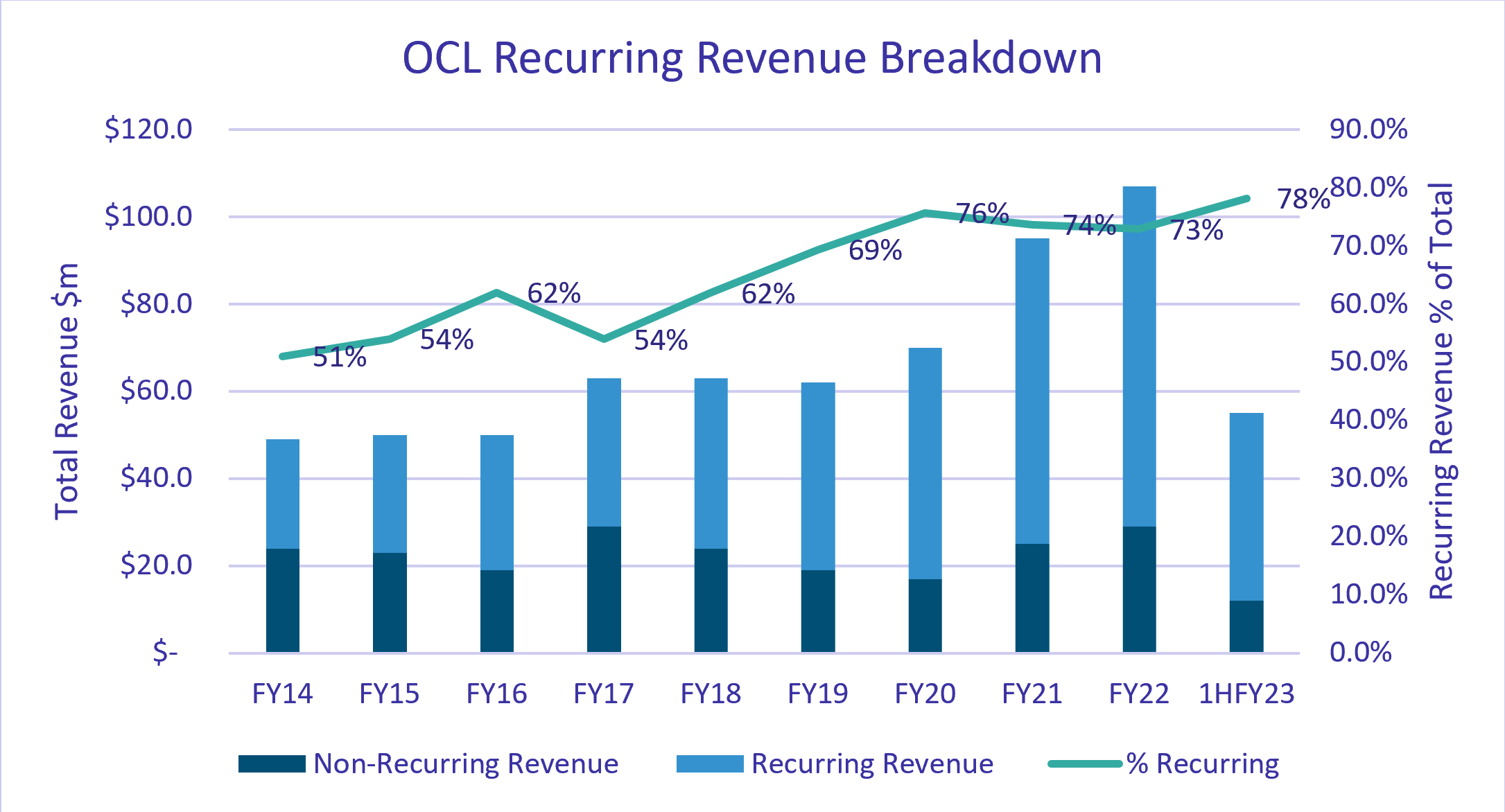
Source: OCL 1HFY23 Investor Presentation
However, what you do see with OCL is (despite the conservative classifications) a greater proportion of the company’s total revenue becoming recurring revenue over time, now at 78% based on the 1HFY23 results. In their recent market commentary OCL mentioned a phasing out of their non-recurring Perpetual Right to Use software revenue as well as focusing less on service type revenues to maximise high quality software recurring software revenues during FY23, which will have the impact of improving the recurring revenue % but softening the overall revenue. Often the trajectory over time is equally, if not more important than the static data to gain a picture about the quality of the underlying revenues. This appears to be the case with OCL undertaking a transition away from non-recurring to revenues.
Subscribe to More Than a Number
From an investor standpoint, it is often not possible to know exactly what a company classifies as recurrent. Hence, specific questions of management are required, together with a thorough read of fine print in presentations and annual reports. Unfortunately, there is also no accounting standard or framework to ensure consistency or benchmarking across businesses.
At NAOS, when assessing future revenue, we believe it important very important to focus on the quality of revenue and how that may translate to earnings and free cash flow. In our experience, this should be considered as part of a much wider analysis of factors such as product positioning, competitive advantages, management track record, industry dynamics and other fundamental drivers of long-term success.
As the world moves more and more towards an on-demand lifestyle, we are likely to continue to see customers gravitate towards subscription models as companies increasingly adapt their businesses to generate consistent and recurring revenues. Investing in companies that can grow earnings in this manner makes logical sense, but we must be aware of the nuances of how revenues can be presented as not all recurring revenue was created equal.
4 topics
2 stocks mentioned

